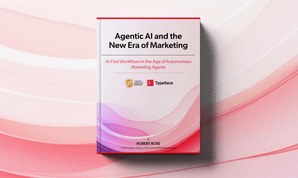AI at Work
Your Guide to AI Marketing Terms: What They Actually Mean

Jason Ing · Chief Marketing Officer
July 24th, 2025 · 11 min read

The worst thing that can happen in an Amazon exec review isn't getting your numbers wrong. It's getting asked: "Tell me what you mean by this word."
I learned this the hard way when presenting to execs at Amazon. You could have the most brilliant strategy, the strongest data, the perfect plan — but if you used a term that wasn't crystal clear, everything would unravel in real time. So I learned to keep my language jargon-free and clear as day. Every word had to earn its place.
But now I'm working in AI marketing, and there's a whole new vocabulary emerging.
And if we're not clear about what we mean by these terms, they become meaningless jargon that sounds impressive but says nothing.
So here's a practical breakdown of the top 10 AI marketing terms that I keep hearing in real conversations with customers — all words had to decode for myself along the way.
The top 10 AI marketing terms you need to know now
1. Orchestration
What it means: AI automatically coordinating multiple marketing tools and channels based on customer behavior and business rules.
Traditional equivalent: Marketing automation or campaign workflows.
In practice: AI decides whether to send an email, show a retargeting ad, or trigger a sales alert based on a customer's specific actions, timing, and engagement history — all happening automatically across different platforms.
Everyday example: When someone abandons their cart, the AI doesn't just send an email. It checks their previous engagement, decides between email or SMS, personalizes the timing based on when they're most likely to engage, and simultaneously adjusts their ad targeting across social platforms — all within minutes.
Common misconceptions:
"It's fully autonomous" - AI orchestration still requires humans to set the rules, goals, and boundaries.
"It replaces all manual campaign management" - Complex strategic decisions and creative direction still need human oversight.
"Any automation is AI orchestration" - Traditional rule-based automation (if X then Y) isn't the same as AI making decisions based on pattern recognition.
Why it matters: It's automation with genuine decision-making capability, allowing for more sophisticated customer journey management than rigid if-then workflows. However, it's only as smart as the data and rules you provide.
2. Intelligent Workflows
What it means: Automated processes that actually learn and adapt based on what's working and what isn't.
Traditional equivalent: Smart campaigns or adaptive automation.
In practice: A workflow that changes the next step based on how someone responded to the previous step, then remembers those patterns for future customers.
Everyday example: Your lead nurturing sequence notices that people who download your pricing guide are 3x more likely to book a demo if they get a case study within 24 hours instead of a generic follow-up email. The workflow automatically starts sending case studies to pricing guide downloaders.
Common misconceptions:
"It learns everything on its own" - You still need to define what success looks like and give it enough data to spot patterns.
"More complex always means better" - Sometimes a simple workflow outperforms an "intelligent" one that's trying to optimize too many variables.
"It works immediately" - These systems need time and data to actually become intelligent.
Why it matters: More flexible than rigid automation, but "intelligent" often just means "tries different approaches and remembers what worked." The real value comes from having enough traffic to make the learning meaningful.
3. Hyper-Personalization
What it means: Using AI to customize content, offers, and experiences for individual users in real-time based on their behavior and characteristics.
Traditional equivalent: Advanced personalization or dynamic content.
In practice: Your website completely changes its layout, messaging, and offers based on who's visiting - not just their industry, but their role, company size, previous interactions, and even how they found you.
Everyday example: Two CFOs visit your SaaS pricing page. One from a 50-person startup sees messaging about "affordable growth" and monthly pricing. Another from a 5,000-person company sees "enterprise reliability" messaging and annual contract options. Same page, completely different experience.
Common misconceptions:
"More personalization is always better" - Too much can feel creepy or overwhelming.
"It reads minds" - It's really just very detailed segmentation based on data points you're collecting.
"It works for small audiences" - You need significant traffic for the personalization to have enough data to be effective.
Why it matters: Can significantly improve conversion rates when done well, but often the biggest gains come from basic personalization done consistently rather than trying to customize everything.
4. Synthetic Data
What it means: AI-generated fake data that looks and behaves like real customer data, used for testing and training without using actual customer information.
Traditional equivalent: Test data or simulated datasets.
In practice: Creating thousands of realistic customer profiles with believable names, behaviors, and purchase patterns to test your personalization engine without touching real customer data.
Everyday example: You want to test if your email personalization works for different customer segments, but privacy rules prevent you from using real customer data in your testing environment. Synthetic data creates 10,000 fake customers with realistic buying patterns so you can test safely.
Common misconceptions:
"It's just random fake data" - Good synthetic data maintains the statistical relationships and patterns of real data
"It completely replaces real data" - It's for testing and development; you still need real data for actual insights
"It's always privacy-safe" - Poorly generated synthetic data can still reveal information about the original dataset
Why it matters: Lets you test and optimize AI systems while protecting customer privacy and meeting compliance requirements. Especially useful when you have limited real data or strict privacy constraints.
5. AEO (Answer Engine Optimization)
What it means: Writing and structuring your content so AI tools like ChatGPT, Claude, and Google's AI can easily find, understand, and cite it when answering user questions.
Traditional equivalent: This is genuinely new - think of it as the next evolution of SEO.
In practice: Instead of just targeting keywords, you're creating content that AI tools can confidently reference when someone asks questions related to your expertise.
Everyday example: When someone asks ChatGPT "What's the best CRM for small businesses" - your comparison guide shows up in the response because you structured it with clear headings, factual comparisons, and authoritative sources that AI can easily parse and cite.
Common misconceptions:
"It's just SEO with a new name" - While related, AEO focuses on being citable by AI rather than ranking in traditional search.
"AI will automatically find good content" - You need to structure content with clear facts, sources, and logical organization.
"It only matters for ChatGPT" - Google's AI Overviews, Bing Chat, and other AI-powered search tools all use similar principles.
Why it matters: As people increasingly ask AI tools for recommendations and information, being discoverable in AI responses becomes as important as ranking on Google. It's where many purchasing decisions now begin.
6. Multi-Modal AI
What it means: AI that can work with different types of content - text, images, video, audio - all at the same time, and create new content across these formats.
Traditional equivalent: Integrated content creation tools or cross-media automation.
In practice: AI that takes your blog post and automatically creates a video script, social media graphics, podcast outline, and email campaign that all work together.
Everyday example: You write a product announcement. The AI creates matching Instagram graphics, a LinkedIn carousel, a 60-second video script, and email subject lines - all maintaining consistent messaging but optimized for each platform's format.
Common misconceptions:
"It creates publication-ready content" - Outputs usually need significant human editing and refinement
"One input creates perfect multi-format campaigns" - Each format has unique requirements that AI doesn't always understand
"It replaces creative teams" - It's better as a starting point generator than a finished product creator
Why it matters: Huge time-saver for content teams by providing first drafts across multiple formats, but human oversight remains essential for quality and brand consistency.
7. Change Management
What it means: The structured approach to helping your team actually adopt and successfully use AI marketing tools, rather than just buying them and hoping for the best.
Traditional equivalent: Training, adoption planning, or organizational development.
In practice: Creating training programs, redefining team roles, and managing the cultural shift as AI takes over routine tasks while people focus on strategy and creativity.
Everyday example: Your company buys an AI content tool. Change management means training your writers on how to use it effectively, redefining their roles to focus on editing and strategy rather than first drafts, and addressing fears about job security openly.
Common misconceptions:
"Good tools don't need change management" - Even intuitive tools require workflow adjustments and skill development
"It's just training" - It also involves addressing resistance, redefining roles, and changing processes
"One training session is enough" - Successful adoption requires ongoing support and adjustment
Why it matters: AI tools are only as effective as your team's ability to integrate them into daily workflows. Most AI implementations fail due to poor adoption, not poor technology.
8. RAG (Retrieval Augmented Generation)
What it means: AI that combines its general knowledge with information from your specific company documents and databases to create content that's accurate to your brand and business.
Traditional equivalent: Knowledge base integration or custom data search.
In practice: AI content creation that references your brand guidelines, product specs, and company policies to ensure outputs stay on-brand and factually correct.
Everyday example: When creating social media posts, the AI pulls from your brand guidelines to match your tone of voice, references your product catalog for accurate features, and checks your current promotions to include relevant offers. Tools like Typeface do exactly this - their AI creates marketing content by referencing your specific brand assets and guidelines, not just generic templates.
Common misconceptions:
"It automatically knows your brand voice" - You need to feed it well-organized brand guidelines, style guides, and examples
"All outputs will be perfectly on-brand" - It's only as consistent as the guidelines you provide
"It works with scattered brand assets" - Requires organized, accessible brand documentation to work effectively
Why it matters: Makes AI-generated marketing content much more consistent with your brand and accurate to your business, but success depends heavily on having your brand guidelines and company information well-organized and current.
9. Forward-Deployed Teams
What it means: Specialized teams (often from AI vendors) that work directly inside your marketing department for months to actually implement and optimize AI tools, rather than just selling them to you.
Traditional equivalent: Implementation consultants or technical account managers.
In practice: A team that embeds with your marketing group for three to six months to set up AI workflows, train your people, and make sure everything actually works in your specific environment.
Everyday example: Instead of buying AI software and trying to figure it out yourself, a specialist team works alongside your marketers daily, setting up campaigns, troubleshooting issues, and training your team until they're confident using the tools independently.
Common misconceptions:
"It's just fancy consulting" - These teams focus specifically on hands-on implementation rather than strategy recommendations.
"They do the work for you permanently" - The goal is to make your team self-sufficient.
"All AI vendors offer this" - It's still relatively rare and usually comes at a premium.
Why it matters: Bridges the gap between AI vendor promises and actual marketing team capabilities. Addresses the reality that most marketing teams don't have the technical expertise to implement complex AI tools successfully on their own.
10. Agentic Workflows
What it means: AI systems that can make a series of independent decisions and take actions within boundaries you set, adjusting their approach based on results.
Traditional equivalent: Rule-based automation with much more flexibility.
In practice: An AI that can research prospects, draft personalized outreach messages, send them, track responses, and adjust its approach for future prospects - all without asking for approval on each step.
Everyday example: Your AI prospecting agent notices that prospects in the healthcare industry respond better to compliance-focused messaging sent on Tuesday mornings. It automatically adjusts its outreach strategy for future healthcare prospects while continuing to test different approaches for other industries.
Common misconceptions:
"It's fully autonomous" - You still need to set clear boundaries, goals, and approval processes.
"It never makes mistakes" - Can create off-brand content or make poor decisions without proper guardrails.
"It works immediately" - Needs time and feedback to improve its decision-making
Why it matters: Represents the "holy grail" of marketing automation - systems that can adapt and improve their own performance. However, still requires careful monitoring to avoid expensive mistakes or brand damage.
Key insights
Most of these AI innovations build meaningfully on traditional marketing automation by adding better pattern recognition and decision-making capability. The AI component is genuine and valuable, though the impact varies significantly by implementation.
Understanding what level of AI sophistication you really need is crucial. Sometimes a straightforward workflow serves you better than an "autonomous agent," and often "hyper-personalization" delivers similar results to well-executed segmentation.
The most important thing is focusing on whether tools solve real problems you're facing and deliver measurable improvements to your marketing outcomes.
What AI marketing terms would you like to see decoded? Follow Jason on LinkedIn, where he'll break them down in future posts.
Share
Related articles

AI at Work
Why AI Rollouts Fail Without Clear Leadership Context (And How to Fix It)

Ross Guthrie · Customer Success Manager
July 16th, 2025 · 14 min read

AI at Work
AI Agents in Marketing: Orchestrating Autonomous Marketing Tasks

Neelam Goswami · Content Marketing Associate
June 27th, 2025 · 13 min read

AI at Work
Agentic AI and the Future of Intentional Work

Robert Rose · Chief Strategy Advisor | Content Marketing Institute
June 16th, 2025 · 7 min read